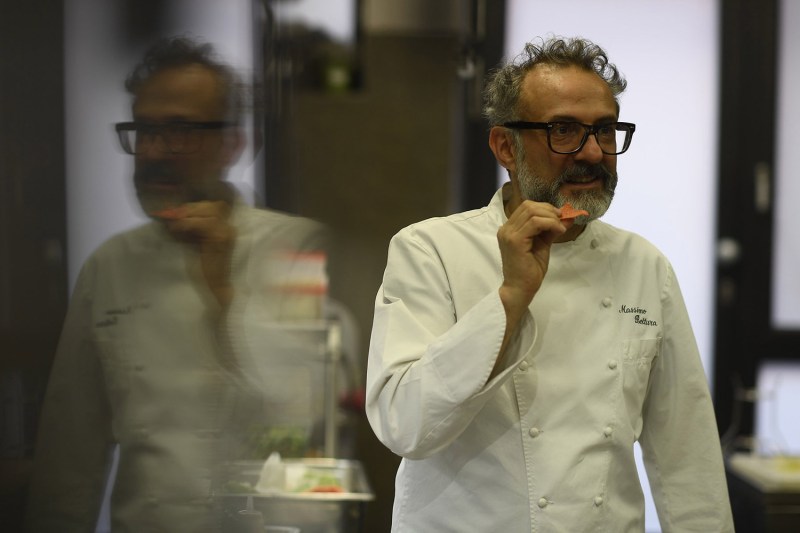Massimo Bottura might be the most convincing chef on the planet. His combination of big personality, post-modern Italian cuisine, and absolute love of all things delicious makes him truly special, even within the crowded confines of the culinary landscape. If you don’t love food already, Botura will change all of that.
The Italian chef is most widely known for his work at Osteria Francescana, a Three-Star Michelin restaurant named best in the world several times over. It’s based in Modena, an Italian city with tons of gastronomical history and that’s known for its vinegar and exceptional cheese. Bottura says it best: “In my blood, there’s balsamic vinegar, and my muscles are made by parmesano reggiano.”

Chefs and big personalities go hand in hand. Just think of the likes of Julia Child, Jamie Oliver, or Anthony Bourdain. Yet there’s something altogether different about Bottura. The chef and restauranteur has never given up his childhood memories and the zest that comes with youth. In fact, that’s exactly what he injects his cuisine with.
Bottura has made the rounds on various cooking programs, but arguably his best work is on the very first episode of Chef’s Table. There, he invites the world into his mind—and the journey is nothing short of remarkable. Without giving the whole episode away (because it’s required viewing for any food lover), there are a few scenes that simply make you fall for food—not in the food porn sort of way that we’re used to now, but in a way that sort of transcends time itself.
In this episode, he talks about some of his earliest food memories, including running around his house evading his three older brothers. “My safety place was in the kitchen under the table, where my grandmother was rolling pasta,” he says. His grandmother would fend off his siblings, waving the pasta roller around while rolling neat morsels of tortellini. “From under the table, I was looking at the world in a different perspective. The flour was falling from the table and I was on my knees, and at that moment, I was stealing the tortellini from under the table.”
It’s a cool and relatable perspective for anybody who grew up with a well-used kitchen, a bit like that iconic scene from Eternal Sunshine of the Spotless Mind, albeit more wholesome and food-driven. “So when they ask me what’s the dish of my life, I say tortellini,” Bottura says, “because I was stealing the rolled tortellini, just made one second before, from the hands of my grandmother.”
It’s enough to make a grown man cry.
He sums the experience up as a driving force for his work in the kitchen. “That’s why food is so important for me—because in the many creations that I do, I’m trying to take you back to that moment,” he says. That’s what makes him an anomaly. He means it, or is at least so convincing you can’t help but believe him.
His ascension is tremendous, though not without its naysayers. Keep in mind that he’s basically turned classic Italian cuisine on its head while still honoring it—a tightrope walk nobody should try. He describes himself as a pigeon in the rafters, observing everything while putting his own stamp on it. He’s taken classic dishes like tortellini and lasagna and put those classic flavors in new, highly-unexpected forms. The masses called it treason at first, but that’s what all the greats are greeted with early on. Now he’s a legend. You get all of those flavors of childhood—especially if you grew up in Italy—in exciting new incarnations.
We don’t know what he’s like off camera, but on, he’s always, well, on. His energy level is unbelievable and entirely fueled by a love for food and creativity. His wife Lara knows him better than anybody. “Massimo is somebody you have to chase. You’re always in his shadow,” she says in the same episode.
Some of his best work
Try to get to his restaurant. Like The French Laundry, it’s likely to change your life. If you can’t do that, you can take in many of his countless merits from the comfort of home. Check him out on the following programs, and keep an eye out for more to come. If you become addicted to his addictive ways, check out his books and appearances in other shows like Stanley Tucci: Searching for Italy, not to mention the 2017 documentary The Quest of Alain Ducasse. There’s never too much Massimo.
- Chef’s Table (Season 1: Episode 1)
- Ugly Delicious (Season 1: Episode 8)
- Master of None (Season 2: Episode 2)


